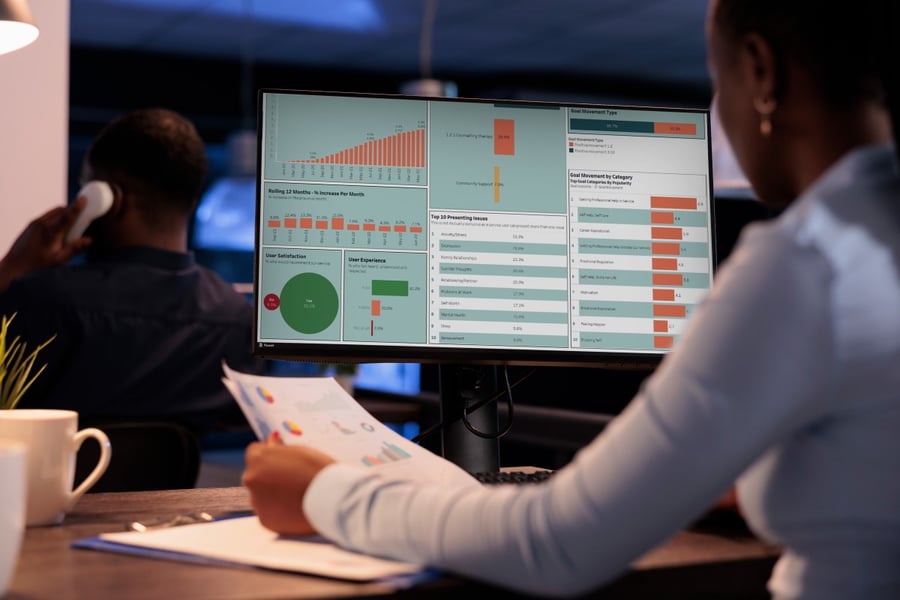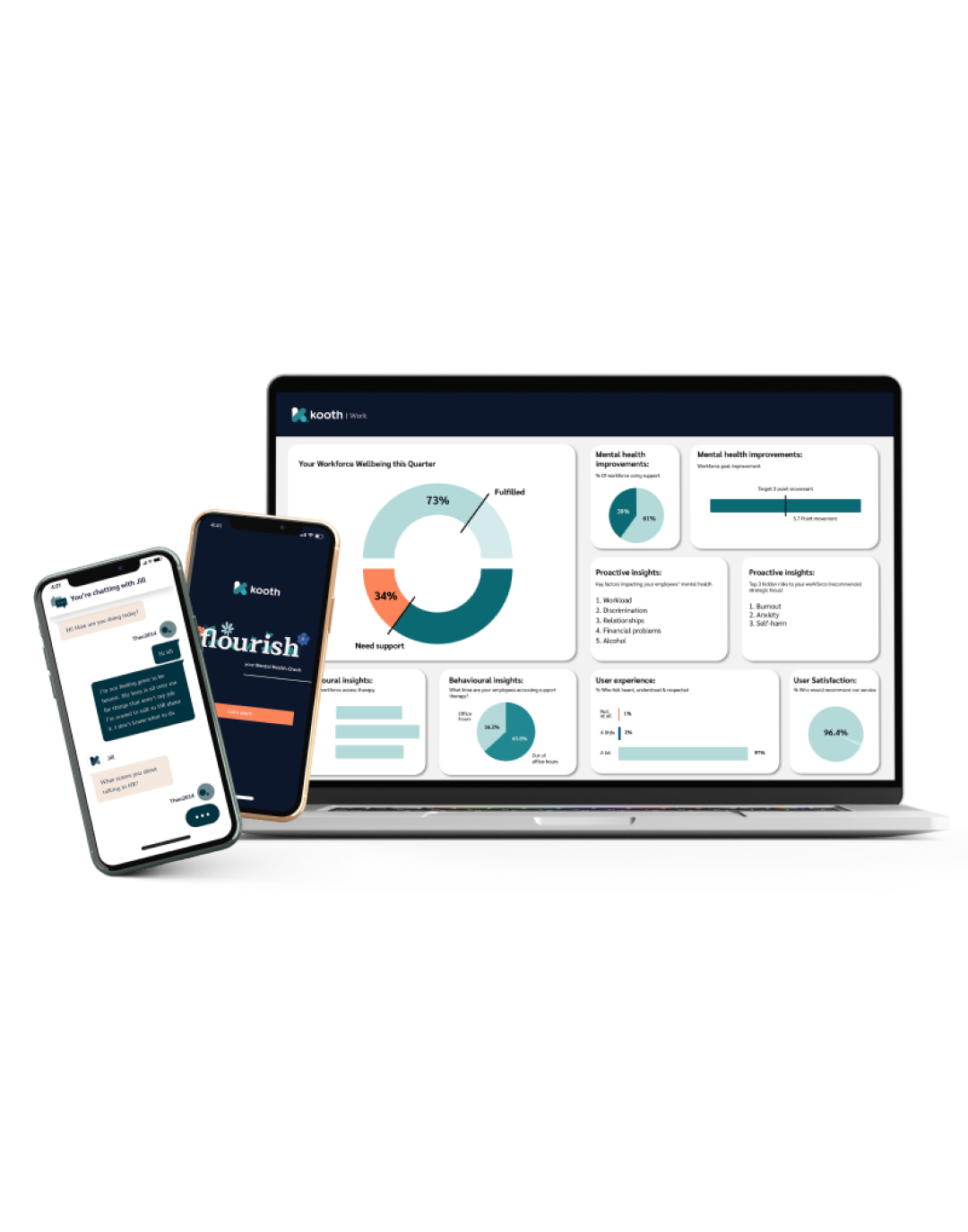KPIs every wellbeing leader needs to monitor
Employee mental health is critical to overall wellbeing and the ability to perform. As an organisational leader, it's important to have access to reporting that can help you measure and improve the mental wellbeing of your workforce. Here are some key data points every wellbeing leader should monitor:
Business KPIs
Let us start at the end. Which is often where most organisations realise there is a problem.
Traditional workforce metrics reported on an HR system or Board pack show only the end result of mental health decline and do not help identify risks early.
High employee absences and leavers can be an indication of a poor work environment or lack of support for mental wellbeing. Keeping track of employee absences and turnover rates can help identify potential issues and take steps to address them. Factors to consider when assessing workforce impact include:
- Absences: what is the reason for long-term absences and sickness? Physical or mental health?
- Presenteeism: are employees checking in to work but their ability to perform their role is inhibited?
- Leavers: why are employees leaving?
- Crisis access: how many employees have needed to use your EAP and private healthcare claims or emergency support?
Mental wellbeing KPIs
While there are many other factors that will influence the reasons people leave or absence levels, it is useful to monitor these metrics.
To make real positive change, better mental wellbeing metrics are needed. Wellbeing leaders will benefit more from gaining insights from data that helps you to become more proactive and effective in preventing people needing crisis support or talent leaving your organisation, let’s look at these now.
1. Clinical scales
There are clinical measures that can help identify specific mental health issues in your workforce and predict the extent of these problems. The following scales can help assess the extent of stress, anxiety, burnout, and depression in the workplace, and provide a baseline for monitoring changes over time:
- Stress: WSAS (Workplace Stress Assessment Scale)
- Anxiety: GAD7 (Generalised Anxiety Disorder 7-item Scale)
- Burnout: CBI (Copenhagen Burnout Inventory)
- Depression: WHO-5 (World Health Organization 5-item Well-being Index)
Once you have a good idea of each of these scales, it is possible to look at the causes.

Tracking workforce mental health using clinical mental health scales
2. Adoption and usage
Employee adoption metrics will help you identify the impact of your support and initiatives. Look for patterns in engagement levels, such as an uptick in registrations and use of support options after an initiative, or a drop in usage among a particular group of employees or a decline in interest over time. Consider the following questions:
- Accessibility: what percentage of your workforce has access to mental health support and are accessing it?
- Registrations: how many people and what proportion of your supported population are registering for each support option?
- Repeat usage: how many people are returning to receive support or a one-off session?
3. Engagement behaviour and hidden risks
In addition to monitoring engagement levels, it’s vital you have a way to monitor engagement behaviour to identify key presenting issues and those hidden issues; identifying these risks can help you develop strategies to tackle the underlying causes of high presenteeism levels, long-term absenteeism, employees leaving, or even acute mental health issues.
By monitoring more descriptive data, you can define themes for engagement initiatives, employee communications, and support offerings to target the issues most relevant to your workforce. When monitoring engagement behaviour and hidden risks, consider:
- Presenting issues: what themes are regularly surfacing?
- Risk levels: which themes are commonly trending and spiking, e.g.,debt and financial stress, suicide, family problems?
Ask your mental wellbeing providers to see what level of insights they provide here.

HR and Wellbeing leaders want useful data
4. Outcomes, feedback and improvements
By signposting employees from your targeted engagement campaigns to your various support options, means you can help facilitate positive change at a workforce level. It is therefore valuable to monitor the outcomes of your initiatives and the support options you provide. The ability to measure outcomes and improvements will help you to track progress.
A good example of this is Goal Movements, as used by the NHS, which aids development by setting personal goal based outcomes and goal movements. It is possible to track the level of attainment of these goals and the amount of movement across your workforce. Consider the following when assessing outcomes and improvements:
- Goal movements: track overall goal movements of your workforce to track improvement. What other outcomes can be measured?
- Clinical measures: define a benchmark and the frequency for assessing your workforce using these defined measures, then track changes to your workforce mental wellbeing in relation to each scale (see section 1) to measure effectiveness of your workplace wellbeing initiatives.
- Employee satisfaction: would they recommend the support options provided?
- User experience: look for patterns in employee feedback responses e.g., did employees feel heard?
- Referrals: what type of referrals are being made to specialist mental health support? What is the scale of these referrals?
A word on employee anonymity, confidentiality, and safeguarding
71% of employees say they want anonymity and privacy, but does this prevent you from receiving effective reporting? The ability to gain insights and monitor these metrics does not mean that anonymity needs to be compromised. For example, Kooth Work’s digital platform provides employers with reporting and clear insights to help monitor the overall mental health of their workforce. While employee users use the system completely anonymously and in a psychologically safe environment.
Safeguarding needs to be applied to all support options, whether as part of an anonymous digital solution or an in-person support option. Wellbeing leaders should check with their providers what safeguarding measures they have in place - e.g. BACP accredited processes to flag and escalate employees at risk.
Summary thoughts
By monitoring these key data points, organisation leaders can gain a better understanding of the mental wellbeing of their workforce and take steps to improve it.
This can include implementing workplace policies and programs that promote mental health, providing access to mental health resources, and encouraging open and honest communication about mental wellbeing. By addressing mental wellbeing in the workplace, organisation leaders can create a more positive and productive work environment for all employees.
Question: What mental health and wellbeing KPIs do you monitor? We’d love to know.
Additional reading:
Flourish workforce mental health check
Why reporting and data insights are key to better workforce mental wellbeing





